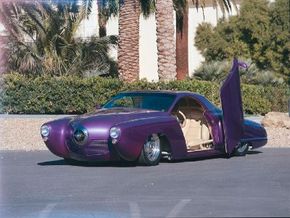In 1990, Thom Taylor drew a bulletnose Studebaker design dubbed Frankenstude as a tongue-in-cheek response to the Larry Erickson-designed CadZZilla™. "I was pushing the bulletnose Studebaker thing because it was the most outrageous, ridiculous car," said Thom. "I wanted to see it done radically and seriously, like CadZZilla™."
Advertisement
Thom shopped his design to friend and noted rod builder Boyd Coddington, but Boyd took a pass. Later, Thom mentioned it to Prior Lake, Minnesota-based race car and rod constructor Greg Fleury. Fleury floated the idea to Minneapolis fine art printer Steve Anderson, who was looking to have a radical car built, and a deal was struck. Thom's drawings were published, and the project began.
Working alone, Greg built the body. He started with a 1948 Starlight coupe, adding a '51 nose and hood, '50 front fenders, and '47 rear fenders. Every panel was massaged to match Thom's drawing, and the door skins, doorjambs, roof, and rocker panels were fabricated from scratch. The bare-steel body was shown in 1992, but it would take almost another five years to complete the car.
Much of the delay was caused by engineering problems that had to be solved. Greg welded the nose into a flip-front-end unit, and engineered it to raise up, move forward, then tilt open with the push of a button. To make the doors open scissor-style, he designed them to first move out away from the body, then turn vertically.
Other body components consisted of Harley-Davidson mirrors, handmade taillights, and custom glass. Town & Country Glass cut down a Pontiac Grand Am windshield to fit and cut the door glass from Ford van windshields.
Thom's design called for the Starlight coupe's characteristic four-piece wraparound rear window to slant forward. The glass was custom-made in two pieces by Glass Pro of Santa Fe Springs, California. A bulletnose was cast in brass to mimic the '50's design, but it replaced the stock "Studebaker" relief with "Frankenstude" lettering.
Though Frankenstude exhibited the radical bodywork of a custom, it would have the engine and chassis of a hot rod. Greg completely fabricated a race car-like 115-inch-wheelbase tube chassis with an integrated roll cage.
Greg designed the tube frame to double as the exhaust system, and installed a Chevrolet L-98 V-8 crate motor. Cotrell Racing Engines of Chaska, Minnesota, tuned the tuned-port-injected 350-cid engine to 400 horsepower. Greg mated it to a GM 700R4 automatic transmission, as well as headers, exhaust pipes, and a driveshaft that he fabricated.
Thom envisioned all-wheel drive, and Greg made it work by using a GMC Syclone all-wheel-drive center section up front, an early Corvette center section in the rear, and a GM all-wheel-drive transfer case. Four-wheel independent suspension and disc brakes were added.
Inside, Greg scratchbuilt the dash, and had it upholstered in bone-colored leather by Bobby Griffey, who also did the seats. Keith Nybo upholstered the door panels, and installed the headliner and carpeting. Vintage Air air conditioning, gauges by Classic Instruments, and a one-off Boyds steering wheel on an ididit steering column completed the interior.
The final touches included custom-mixed House of Kolor Frankenstude Purple paint sprayed by Rand Bailey and a set of 17-inch billet wheels custom-made by Boyd Coddington. Six-and-a-half years in the works, several scale replicas made it to market before the full-size project was complete.
The finished Frankenstude made its debut in an exhibit at the Minneapolis Institute of Art. Within the car community, its unique design, complex engineering, and robust performance potential made it a hit. Frankenstude, like CadZZilla™, helped launch a new wave of customs conceived as a modern take on '50s cars.
Steve Anderson kept the car until 2000, when he sold it to Steve and Mary Barton of Las Vegas. The Bartons switched out the rear suspension for air suspension by Air Ride Technologies. As Steve put it, he and his wife wanted the car because "it's a magnificent custom with a perfect design."
Advertisement
